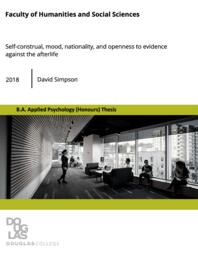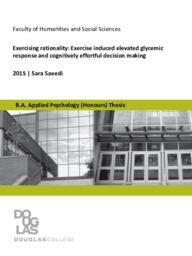Psychology
Related Works
Content type
Digital Document
Abstract
We examined behavior problems in 80 adolescents (39 male; mean age = 15.74 years) adopted in early childhood by Canadians from globally depriving Romanian institutions. Overall, rates of clinically significant behavior problems were comparable to rates found in younger postinstitutionalized adopted children. The association between duration of deprivation before adoption and behavior problems indicated relatively less lasting impact of deprivation on the behavior problems of adolescents who were adopted prior to 2 years of age. Measures of attachment, communicative openness about adoption, and exposure to culture of origin, which have been theoretically and, to a lesser extent, empirically linked to adjustment in postinstitutionalized adoptees were unrelated despite their apparent common conceptual link to sensitive parenting. Attachment and communicative openness were each significantly and negatively correlated with behavior problems; exposure to culture of origin was not. Hierarchical regressions revealed independent contributions of attachment and communicative openness to predicting behavior problems in postinstitutionalized adolescents.
Origin Information
Content type
Digital Document
Abstract
The Dark Triad Traits (DTT: consisting of Psychopathy, Machiavellianism, and Narcissism) are clearly linked to deceptive and manipulative behaviour, yet little is known about whether people with high levels of DTTs deceive themselves in order to convince others. This online study investigated whether the DTTs predicted false memory levels, assessed by the DRM paradigm (Deese, 1959: Deese & McDermott, 1995), which was modified to include three neutral word lists and three word lists constructed around DTT-related lures (Power, Control, and Status). The sample (n=161) consisted of 136 females and 25 males from the undergraduate research pool and through social networks. Among the three DTTs, psychopathy was most closely predictive of self-reported dishonesty. However, results showed that psychopathy and narcissism significantly predicted lower rates of adopting false memories for neutral lures, whereas Machiavellianism was somewhat predictive of adopting higher false memory levels, particularly for the DTT lure (control). These findings indicate that among the DTTs, psychopathy and narcissism are associated with a lower likelihood of self-deception, while Machiavellianism may increase the probability of self-deception.
Origin Information
Content type
Digital Document
Abstract
There is considerable evidence that people process information in a manner that favours prior beliefs, and that they are resistant to evidence against those beliefs. People who believed in an afterlife were recruited, and they all indicated their level of confidence. This study analyzed the effect of self-construal, mood, and nationality on openness to belief-contradicting evidence. Our study used a 2 (self-construal: rational vs fallible) X 2 (mood: positive vs negative) X 2 (nationality: Western vs non-Western) factorial design. Self-construal was manipulated through the use of questionnaires, while mood was manipulated with videos. All participants were exposed to arguments that contradicted their beliefs, and they indicated how convincing the arguments were. Their ratings of the arguments were our measure of openness to belief-contradicting evidence. There was a strong negative correlation between initial belief confidence and ratings of the arguments. Participants who were more confident in their beliefs tended to find the arguments unconvincing, but participants with less confidence tended to find the arguments convincing. Self-construal did not produce significant differences in ratings of the arguments, and neither did the mood manipulation. There was also no significant difference in average ratings between Westerners and non-Westerners. However, there was an unexpected interaction between nationality and self-construal. A fallible self-construal led to significantly lower ratings of the arguments for Westerners, while it led to higher ratings of the arguments for non-Westerners. Possible explanations of this finding are discussed, including identity threat and differences is self-serving bias.
Origin Information
Content type
Digital Document
Abstract
Although there has been extensive research on the independent predictor variables of high school drop out, less research has been dedicated to explaining the relationships among these variables. This exploratory study examined the relationship between socioeconomic status (SES) and academic self-efficacy, specifically to see if delay discounting could be acting as a moderator between the two variables. Participants were 20 high school students from a medium-sized city in Western Canada, all enrolled in a dropout prevention program. Data was collected via surveys on three separate occasions throughout the program. The results indicated a non-significant positive correlation between SES measures and academic self-efficacy. Delay discounting, defined as lack of willingness to wait for larger, but delayed rewards, had a non-significant negative correlation with both academic self-efficacy and two of three SES measures. Delay discounting was a significant moderator of the relationship between SES and academic self-efficacy. Lastly, the early school-leaving sample was found to have significantly higher levels of delay discounting than a college-based comparison sample. These findings suggest that the individual difference variable of delay discounting may help explain inconsistent relationships between socioeconomic background and likelihood of academic success.
Origin Information
Content type
Digital Document
Abstract
Caffeine is one of the most ubiquitous drugs in the world, and is often consumed for its cognitive enhancing properties. The current research investigated the influence of caffeine on two commonly used measures of risky decision making (the Iowa Gambling Task and the Balloon Analogue Risk Task). Findings indicated that caffeine improved performance on the IGT but not on the BART. However, inclusion of individual differences on decision making style and impulsivity generated regression models that explained a significant proportion of variance in performance on the IGT and BART. Multiple significant correlations existed among a variety of individual difference trait measures of decision-making style, impulsive tendencies and risk-taking behaviour. Results and implications are discussed in terms of two prominent decision-making theories as well as prior research, and further research directions are suggested that may help elucidate the apparently contradictory effects of caffeine on two distinct measures of risky decision making.
Author keywords:
Origin Information
Content type
Digital Document
Abstract
This study observed Systems 1 (heuristic) and Systems 2 (cognitively effortful) decision making styles in individuals undergoing high and low intensity exercise versus a no exercise control group. The attraction effect and delay discounting were measured to test the hypothesis that post exercise hyperglycaemia can reduce heuristic-based decision making and increase cognitively effortful decisions. Individual differences in decision making traits were also assessed using the General Decision Making Styles questionnaire. Results showed that high-intensity exercise can induce elevation in blood glucose; however this effect was observed only in half the sample. Participants in the high intensity exercise condition were significantly more likely than those in the low intensity exercise condition to elicit post exercise hyperglycaemia. Additionally, results from this study show that higher blood glucose is associated with a greater probability of choosing the non-heuristic option in the apartment task; thus signifying less reliance on heuristic based System 1 decision making. Furthermore, in the delay discounting task, exploratory analyses suggest that high-intensity exercise-induced hyperglycaemia may rescue optimal decision-making for individuals who tend to make more intuitive decisions (i.e., are more reliant on System 1). Further studies with larger sample sizes are needed to further elucidate the effects of exercise on decision making, taking into account blood glucose changes and individual difference profiles.
Origin Information






